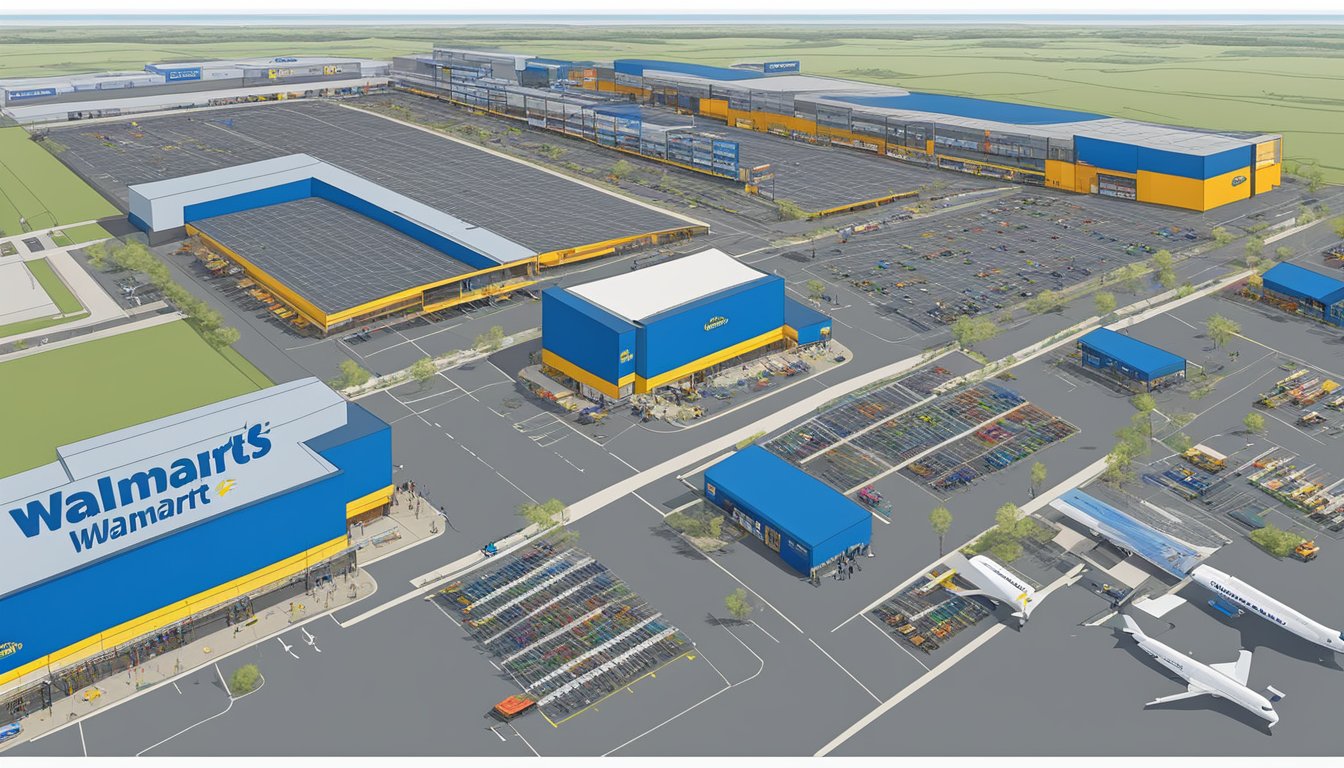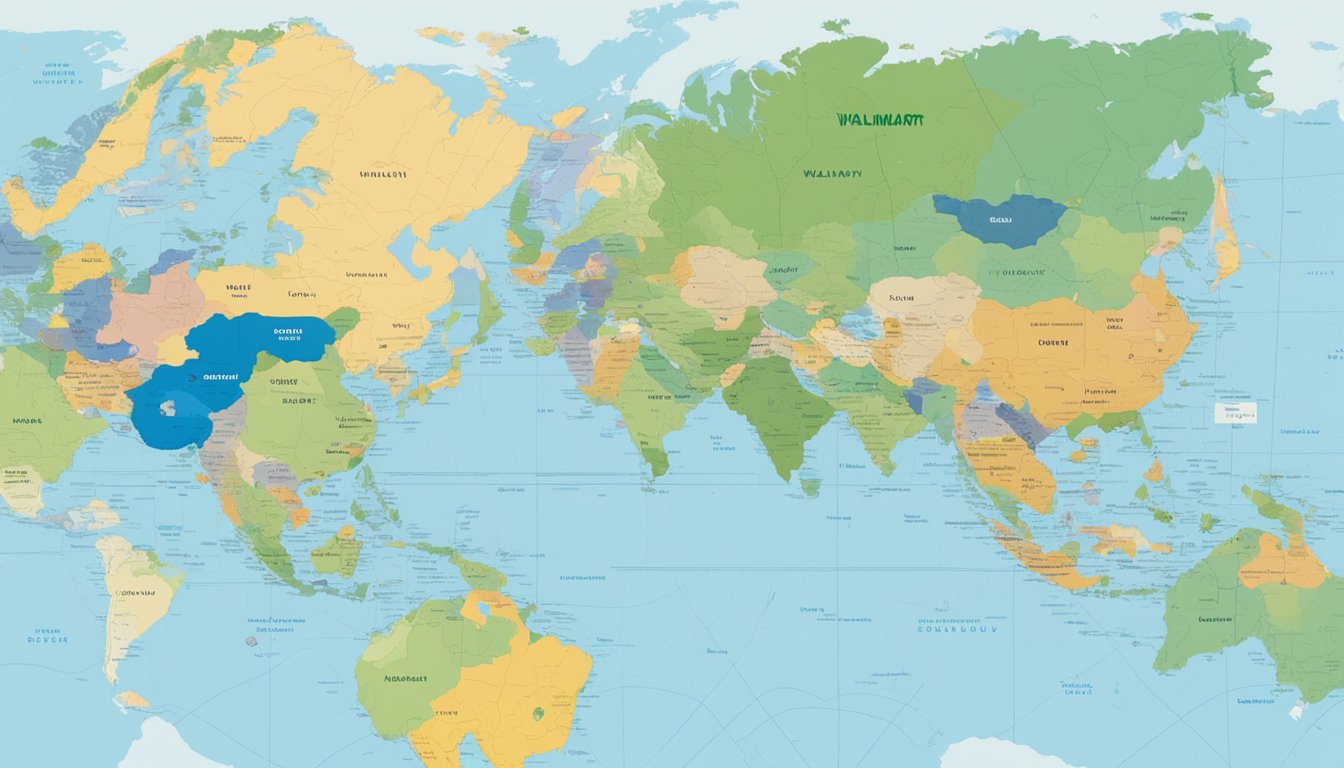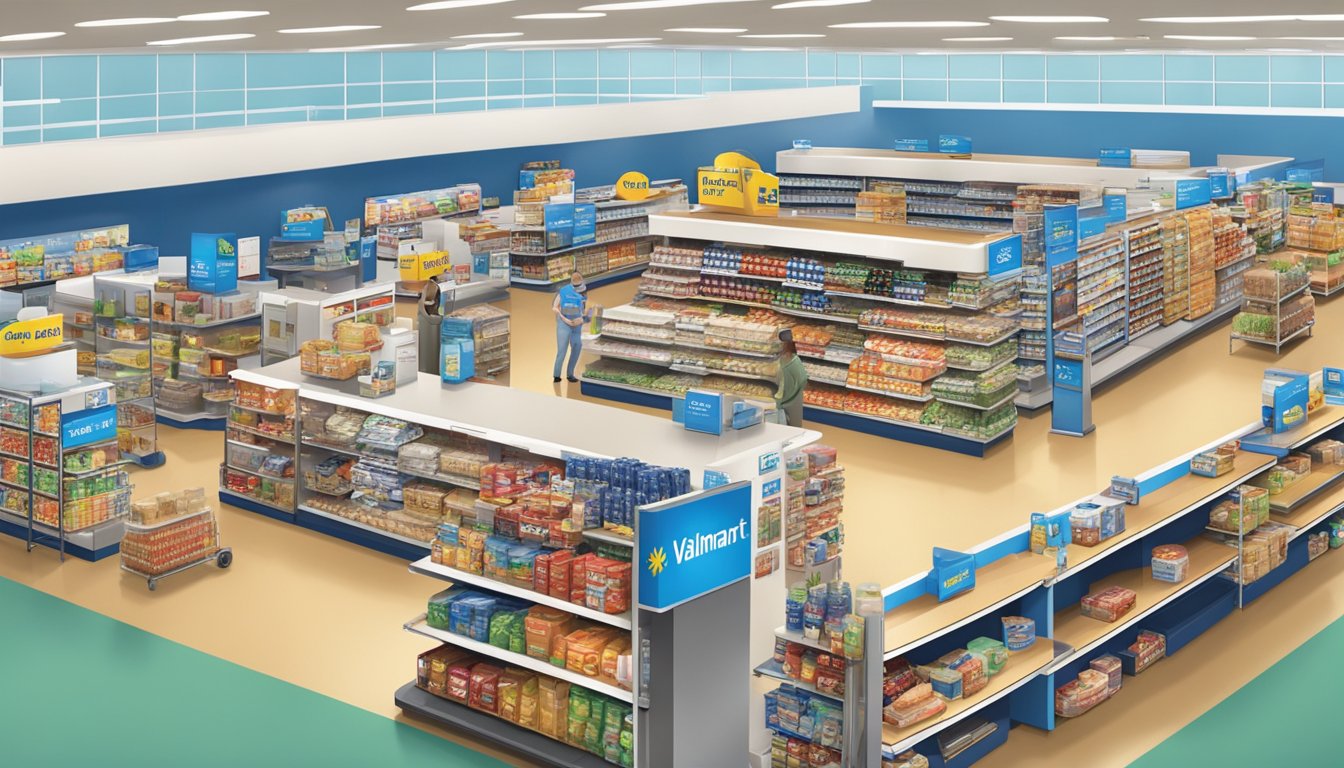Walmart, founded by Sam Walton in 1962, has grown from a single discount store in Rogers, Arkansas, to the world’s largest retailer. Recognized for its vast range of products and low prices, Walmart has solidified its presence in the retail sector not only in the United States but worldwide. The key to Walmart’s expansive reach has been its strategic acquisitions, allowing the corporation to enhance its offerings and penetrate various retail markets and segments.
These acquisitions extend from e-commerce giants to smaller retail chains across several countries. Walmart’s portfolio includes a multitude of companies that diversify its operations from traditional brick-and-mortar stores to online marketplaces, providing a comprehensive shopping experience for customers. The company’s approach to growth through ownership of diverse businesses has also enabled it to create a strong online presence, adapt to changing market trends, and engage in innovative branding and marketing strategies.
Key Takeaways
- Walmart is the world’s leading retailer, established by Sam Walton and expanding through strategic acquisitions.
- It has a diverse business structure that supports both physical and online retail segments.
- Walmart prioritizes customer experience and incorporates corporate responsibility into its operations.
Walmart’s History and Founders
https://www.youtube.com/watch?v=YA7KuAlk-8Q&embed=true
Walmart, a retail giant known for its vast selection and low prices, was brought to life by the vision and leadership of its founder, Sam Walton. Its roots are deeply planted in the soil of Rogers, Arkansas, where the first store welcomed its initial customers.
The Walton Family Legacy
Sam Walton paved the path for what would become a retail empire when he opened the first Walmart store on July 2, 1962, in Rogers, Arkansas. His focus on maintaining low prices to drive higher volume sales was revolutionary for the time and established the cornerstone of Walmart’s success. Walton’s ideals and leadership not only sparked growth for the company but also fostered a strong family-owned business atmosphere that has withstood the test of time.
The Walton family has played an integral role throughout the history of the company. Following the opening of the inaugural store, the family’s involvement has been constant. By 1967, they owned 24 stores and achieved $12.7 million in sales. Today, they continue to hold a significant influence over the company’s operations, ensuring that Walton’s original principles of value and service remain at the heart of the Walmart experience.
Walmart’s Business Structure
Walmart’s business structure incorporates a vast network of entities, strategic acquisitions, and a complex, hierarchical management system. These elements collectively drive the operations and growth of the world’s largest retailer.
Subsidiaries and Acquisitions
Walmart, through strategic acquisitions, has expanded its reach far beyond its original retail stores. Its subsidiaries comprise a range of store formats including supercenters, discount stores, and grocery stores. Notable acquisitions such as Jet.com have bolstered Walmart’s e-commerce presence, adapting to the evolving retail landscape. The company also operates under different banners in international markets, such as Asda in the United Kingdom, which was previously owned by Walmart but sold in 2021.
- U.S. Retail: Includes retail stores operating under ‘Walmart’ and ‘Sam’s Club’.
- E-commerce: Comprises various online platforms such as Jet.com, although Jet was later phased out its technology continues to support Walmart’s infrastructure.
- International Holdings: Consists of operations in numerous countries like Mexico and Canada under names such as Walmart de México y Centroamérica.
Walmart Inc and Its Divisions
Walmart Inc. is the parent company that oversees and manages its various branches and subsidiaries. It is guided by a team of executives and a board of directors responsible for making key decisions affecting the company’s direction.
- Management: Led by a CEO who directs the company’s overarching strategies and its divisions.
- Ownership of Walmart: Controlled predominantly by the Walton family, with significant shares held by institutional investors like the Vanguard Group, one of the largest shareholders.
- Shareholders: A mix of public and private investors that includes both institutional entities and individual investors who have invested in the company through the purchase of stocks. The diverse ownership underscores the retailer’s expansive scale.
Walmart’s reach and operational scope continue to evolve as it scales and adapts in a dynamic marketplace, leveraging its diverse portfolio and robust management structure.
Key Financials
In assessing Walmart’s financial robustness, one should consider its market capitalization, which reflects investor confidence, alongside its revenue generation capability. These figures serve as barometers of Walmart’s economic scale and operational success.
Market Capitalization and Revenue
Market Capitalization: As one of the world’s leading publicly traded companies, Walmart commands a significant market capitalization. The company’s market value is a testament to its vast scale and the investor trust it maintains.
- Revenue: Walmart consistently showcases strong revenue figures, indicative of its extensive sales network and effective business strategy. Revenue trends reflect its ability to generate sales both domestically and internationally, propelling it forward in the retail sector.
It’s important to note that revenue encompasses the total sales of goods and services within a given period, whereas net income accounts for the company’s profit after all expenses have been paid. Investors closely watch these numbers to gauge performance and future prospects.
Global Operations
Walmart’s vast network effortlessly spans across various continents, adapting to local markets while consistently expanding its retail empire.
Walmart International
Canada: Walmart entered the Canadian market through the acquisition of the Woolco chain in 1994. Today, they have grown to operate over 400 stores throughout Canada.
United Kingdom: The acquisition of Asda in 1999 marked Walmart’s venture into the UK market. Although Walmart sold Asda in 2021, they retained an equity investment and board presence, maintaining a stake in UK’s retail sector.
Japan: Walmart had a presence in Japan by holding a majority stake in Seiyu since 2008, but they later sold most of their interest while keeping a portion of the shares, marking a strategic partnership with Rakuten.
South Africa: In 2011, Walmart made a significant investment in the continent by acquiring a majority stake in Massmart, which includes popular retail chains such as Game, Makro, Builders Warehouse, and Jumbo.
India: Walmart’s significant acquisition of Flipkart in 2018 boosted their presence in India, becoming a major player in one of the largest and fastest-growing markets.
Brazil: Walmart entered Brazil by acquiring Bompreço and Hiper Bompreço supermarket chain. Though they sold a portion of their operations, Walmart has a continuing presence in Brazil’s retail market.
China: Walmart has been expanding in China since 1996 and has established a foothold with over 400 retail units, adapting to local tastes and e-commerce trends.
Mexico: Operating under the name Walmex, Walmart has become the largest retailer in Mexico, showcasing their successful adaptation to the local market.
Expansion and Local Chains
In each international market, Walmart tailors its operations to the local context, whether it’s offering familiar brands under the umbrella of Massmart in Africa or integrating with eCommerce platforms in India. They not only adapt existing chain stores but also increase their footprint by establishing new locations that align with the Company’s global standards and practices.
By carefully navigating local business climates and consumer preferences, Walmart ensures that its portfolio of companies, ranging from large hypermarkets to smaller supermarket chains, effectively serves a diverse global customer base. Through these strategic moves, Walmart prominently positions itself as a key player not just in North America but around the world.
Retail Segments and Products
Walmart is well-known for its vast array of products that cater to various consumer needs, which include electronics, groceries, apparel, and more. The retailer ensures that customers can find a comprehensive range of items all under one roof.
Diverse Merchandise Offerings
Electronics: Walmart provides customers with a broad selection of electronics ranging from the latest smartphones and TVs to gaming consoles and laptops.
Walmart’s Online Presence
https://www.youtube.com/watch?v=vAL2YtZRiIY&embed=true
Walmart has significantly expanded its online reach to become a powerful e-commerce company, challenging other giants in the digital marketplace and reshaping how consumers shop.
E-commerce Growth
Walmart’s journey as an online retailer has been marked by rapid growth and strategic acquisitions. Notably, the acquisition of Jet.com played a pivotal role in bolstering Walmart’s e-commerce strategy. By integrating Jet.com’s innovative technology and expertise, Walmart improved the online shopping experience on Walmart.com, enhanced its supply chain, and expanded its assortment of products. Walmart’s persistent efforts have illustrated a strong commitment to growing its e-commerce footprint and adapting to consumers’ changing needs.
Competing with Amazon
In the highly competitive sphere of online shopping, Walmart has been a formidable opponent to Amazon.com, focusing on leveraging their physical stores to facilitate online purchases and offering alternative services, like subscription programs. Initiatives such as Walmart+ aim to provide value through exclusive benefits, tapping into a model similar to Amazon’s Prime service. Walmart’s e-commerce websites engage in direct competition by offering large-scale online events, rivaling Amazon’s signature sales like Prime Day with their own versions that drive traffic and sales.
Through these strategies, Walmart continuously adapts and expands its online presence, presenting themselves as a compelling choice for consumers who value convenience, variety, and competitive pricing. They demonstrate a proactive approach in the digital retail landscape, steadily increasing their hold as a leading e-commerce destination.
Branding and Marketing
https://www.youtube.com/watch?v=OgNnIn_juPo&embed=true
In the realm of retail, Walmart’s mastery in branding and marketing has become a cornerstone of their success. They’ve crafted a reputation for affordability without compromising quality, particularly through their private label brands in various categories including clothing and online menswear.
Advertising and Customer Perception
Walmart has established a strong brand presence by effectively advertising their wide array of products, from grocery items to electronics, and even clothing lines. Their marketing campaigns often emphasize value for money, which resonates with a broad consumer base. They strategically position their private label brands, such as Great Value and George, an online menswear and clothing range, to compete with other national brands.
The perception of Walmart’s brands is carefully shaped by not only traditional advertising but also through the utilization of digital platforms. By leveraging the data from millions of shoppers, they’ve fostered a highly targeted marketing approach, which improves customer experiences and brand loyalty. Walmart offers a diverse product mix, including the marketing of their private label brands, which are bought by a significant portion of US consumers, according to insights on Walmart’s brand penetration.
Their marketing strategy is not solely focused on in-store experiences. Walmart has expanded its branding efforts into the digital realm by enhancing their online presence, particularly within the clothing and menswear sectors. The inclusion of online menswear not only broadens their market but also meets the growing demand for convenient shopping experiences. Walmart’s approach illustrates the significance of versatile and adaptive marketing strategies in the retail industry.
Customer Experience and Services
https://www.youtube.com/watch?v=Hy1FW0CChlE&embed=true
Walmart is recognized for its expansive network of brick-and-mortar stores and its growing e-commerce presence. They ensure that their customer experience evolves by integrating online and physical shopping environments, offering services like same-day delivery that cater to the convenience of the customer.
Brick-and-Mortar vs Online Shopping
Brick-and-Mortar Retail: Walmart operates a vast number of physical stores that offer a variety of products. These stores are designed to give customers an engaging in-person shopping experience. They have implemented measures to streamline the shopping experience, such as self-checkout kiosks and the Walmart app, which can help customers navigate the store and quickly locate items.
Online Shopping: On the digital front, Walmart has expanded its online shopping capabilities significantly. Services like online grocery ordering with options for pickup or same-day delivery make it convenient for customers to shop without physical store limitations. Walmart’s acquisition of an online lingerie company demonstrates their commitment to reinvent their online retail segment and reach new demographics through specialized e-commerce platforms.
Corporate Responsibility
https://www.youtube.com/watch?v=wTidplpkqZE&embed=true
Walmart’s approach to corporate responsibility emphasizes measurable impacts in numerous areas, including environmental sustainability and fostering a sense of community. Their initiatives are crafted to align with the diverse needs and inclusivity of its workforce, and reflect their commitment to social responsibility.
Sustainability and Community Engagement
Sustainability: Walmart is deeply invested in reducing its carbon footprint and aiding suppliers in their green initiatives. They have reported significant reductions in emissions since 2017, and their strides in sustainability reach further with efforts to build a comprehensive EV charging network across their locations.
- Goals:
- Reduce emissions: Target over 1 billion metric tons (Gigaton) by 2030.
- Renewable energy: Aspire to power 50% of operations with renewable energy by 2025.
Community Engagement: Walmart engages with local communities through its hiring practices and philanthropic contributions. They ensure that community enrichment and diversity are prioritized, with special attention to training and promoting underrepresented groups within its workforce. Through their foundation, they also contribute to community welfare, including support for small- and medium-scale farmers, over half of whom are women, as evidenced in their 2018 Global Responsibility Report.
- Initiatives:
- Inclusive hiring and promotion: Over 230,000 associates promoted, focusing on elevating a diverse workforce.
- Philanthropy: More than $1.5 billion in cash and in-kind donations for global community support.
Notable Acquisitions and Partnerships
https://www.youtube.com/watch?v=BxDmbGFABJw&embed=true
Walmart’s growth strategy has significantly included the acquisition of various companies and strategic partnerships, which have expanded its reach into different sectors and enhanced its e-commerce capabilities. Below are some notable acquisitions:
-
Jet.com: A substantial e-commerce platform acquired for approximately $3.3 billion in 2016, was a move to strengthen Walmart’s online presence against competitors like Amazon.
-
Shoebuy: Now known as Shoes.com, was one of the initial steps into specialized e-commerce, focusing on footwear.
-
Moosejaw: In 2017, Walmart targeted outdoor recreation and apparel by acquiring Moosejaw, which brought along a strong lineup of brands in the outdoor category.
-
Bonobos: Walmart also acquired Bonobos, a menswear site, broadening its clothing inventory with a focus on fashion-forward menswear.
-
ModCloth: Known for vintage-inspired dresses and eclectic clothing, ModCloth was part of Walmart’s move to diversify its apparel options.
-
Flipkart: One of their largest international bets, Walmart acquired a majority stake in Flipkart, an Indian e-commerce giant, for $16 billion.
-
Bare Necessities and ELOQUII: They’ve even reached into niche clothing markets focusing on plus-size women’s fashion with ELOQUII and intimate apparel through Bare Necessities.
-
Aspectiva: This acquisition underscores Walmart’s interest in incorporating artificial intelligence and analytics to enhance the shopping experience.
-
Parcel: To improve delivery logistics, Walmart acquired Parcel, a technology-based, same-day and last-mile delivery company.
Each of these acquisitions reflects not just expansion but Walmart’s intention to diversify and modernize its offerings to meet the evolving needs of consumers.
Frequently Asked Questions
In this section, you’ll find answers to common questions regarding Walmart’s leadership, the retailers it owns, its global footprint, historical background, and its relationship with Sam’s Club.
Who is the current CEO of Walmart?
The current CEO of Walmart is Doug McMillon. He has held this position since 2014, overseeing the company’s operations globally.
Can you list some of the retailers that Walmart has ownership in?
Walmart’s portfolio includes a variety of retailers, such as the warehouse chain Sam’s Club and numerous international chains like Flipkart, a leading online retailer in India, and Massmart, a South African retailer.
What are the main countries where Walmart operates?
Walmart operates in 24 countries around the world, including the United States, Canada, Mexico, China, and several countries throughout Africa, Central America, South America, and Asia.
How extensive is Walmart’s global store presence?
Walmart has a substantial global presence with over 11,000 stores, featuring a blend of hypermarkets, discount department stores, and grocery stores.
What is the historical background of Walmart?
Sam Walton founded Walmart in 1962 with the opening of the first discount store in Rogers, Arkansas. Over the years, it grew to become a multinational corporation known for its vast array of merchandise and competitive pricing.
What is the relationship between Walmart and Sam’s Club?
Sam’s Club is a chain of membership-only retail warehouse clubs that are owned and operated by Walmart Inc. It was founded in 1983 and named after Walmart’s founder, Sam Walton.











